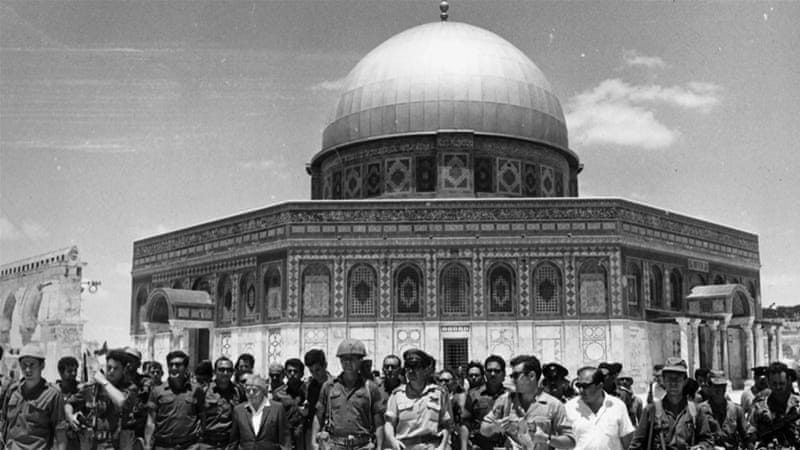by ZENA TAHHAN
 Israeli leaders after the capture of East Jerusalem at the the Dome of the Rock in the al-Aqsa Mosque Compound in June, 1967 PHOTO/Getty Images
Israeli leaders after the capture of East Jerusalem at the the Dome of the Rock in the al-Aqsa Mosque Compound in June, 1967 PHOTO/Getty Images
Palestinians are marking 51 years since the 1967 occupation of their remaining lands this week.
More than 50 years ago, the state of Israel shocked the world when it seized the remaining Palestinian territories of the West Bank, East Jerusalem, Gaza Strip, as well as the Syrian Golan Heights and the Egyptian Sinai Peninsula, in a matter of six days.
In a war with Egypt, Jordan and Syria, known as the 1967 War, or the June War, Israel delivered what came to be known as the “Naksa”, meaning setback or defeat, to the armies of the neighbouring Arab countries, and to the Palestinians who lost all what remained of their homeland.
The Naksa was a continuation of a prior central event that paved the way for the 1967 war. Nineteen years earlier, in 1948, the state of Israel came into being in a violent process that entailed the ethnic cleansing of Palestine.
Zionist forces, in their mission to create a “Jewish state”, expelled some 750,000 Palestinians from their homeland and destroyed their villages in the process. Shortly after Israel declared statehood, units of the neighbouring Arab country armies came in to fight for the Palestinian nation.
The 1948 war ended with Israeli forces controlling approximately 78 percent of historical Palestine. The remaining 22 percent fell under the administration of Egypt and Jordan.
In 1967, Israel absorbed the whole of historical Palestine, as well as additional territory from Egypt and Syria. By the end of the war, Israel had expelled another 300,000 Palestinians from their homes, including 130,000 who were displaced in 1948, and gained territory that was three and a half times its size.
Why did the war break out?
The narrative of the war is highly polarised, as is common for many events in the Arab-Israeli conflict. There exists, however, a series of events that undeniably led to the outbreak of the war.
Firstly, there were frequent clashes on the Israeli-Syrian and Israeli-Jordanian armistice lines after the 1948 war. Thousands of Palestinian refugees tried to cross the border searching for relatives, attempting to return to their homes and to recover their lost possessions.
Between 1949 to 1956, it is estimated that Israeli forces shot dead between 2,000 to 5,000 people who tried to cross.
In 1953, Israel committed the most notorious reprisal massacre in the West Bank against the village of Qibya, where 45 houses were blown up and at least 69 Palestinians were killed.
A few years later, the Suez Crisis took place in 1956. Israel, along with France and Britain, invaded Eygpt with the hope of toppling then President Gamal Abdel Nasser after he nationalised the Suez Canal Company. The company was a joint British-French enterprise which controlled and operated the strategic waterway.
Al Jazeera for more